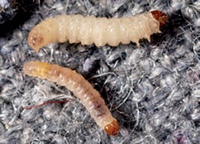The hind wings are smaller in comparison and lighter coloured.
Carpet moth larvae identification uk.
It inhabits mature deciduous woodland where lichen covers the trunks and branches of the trees.
Identifying a carpet moth the carpet moth is smaller than a common house moth.
If you spot a tiny grub wrapped in a woven case dragging itself around you ve got carpet moths.
How can i tell if i have carpet moths.
Their larvae are most likely to be found munching away underneath some of your bigger and heavier furniture that you rarely move to vacuum.
Have a look at our moth id sheet to work out what kind of moth you have spotted.
Case bearing carpet moth larvae on fabric.
Adult webbing clothes moths have a wingspread of about 1 2 inch and that of the male is somewhat less.
What s ukmoths all about.
See the moth identification guides on this site for more information.
There are two species of carpet moth found in the uk.
Brown with a metallic silver y shaped mark on each forewing one of the most commonly seen day flying.
Identify webbing clothes moth larvae by their feeding tunnels of silk or webbing patches left behind on the fabric as they move around.
Step 2 assess the intensity of your infestation use carpet moth traps to identify how much of a problem you may have unlike many other types of moths.
Alamy i f you have never heard of the case bearing carpet moth tinea pellionella you are lucky they have probably not invaded your home.
Carpet moths are buff coloured with forewings that usually have three distinct dots.
Ukmoths has been providing identification help and information about britain s moths for over 15 years.
Neither species is as common indoors as it used to be as indoor temperatures tend to be too high for them these days due to central heating.
The carpet tapestry moth trichophaga tapetzella and the case bearing carpet moth tinea pellionella.
Carpet moth eggs are so small you won t notice them but their larvae are easily identified due to the case they carry around which gives them their common name.
Traditionally moth fieldguides have concentrated on the so called macro moths of which there are around 800 regular species.
Here the moths can rest unseen with their superb cryptic camouflage.
With a body about 5mm long and a wingspan of about 14 18mm.

